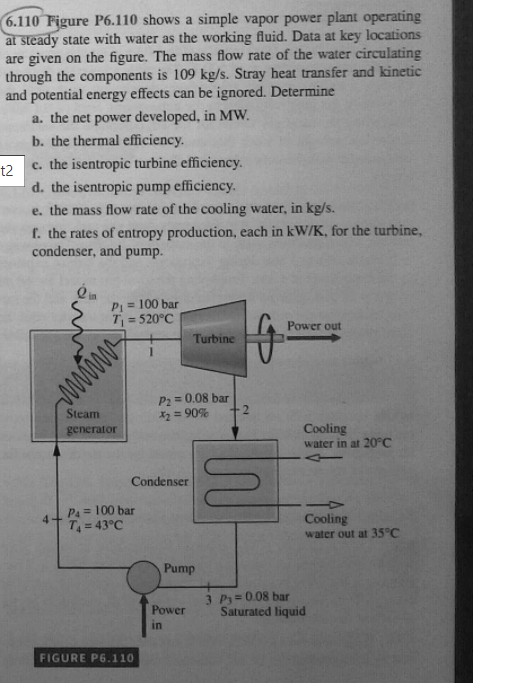6.110 Figure P6.110 shows a simple vapor power plant operating at steady state with water as the working fluid. Data at key locations are given on the figure. The mass flow rate of the water circulating through the components is 109 kg/s. Stray heat transfer and kinetic and potential energy effects can be ignored. Determine a. the net power developed, in MW. b. the thermal efficiency. c. the isentropic turbine efficiency. d. the isentropic pump efficiency. e. the mass flow rate of the cooling water, in kg/s. f. the rates of entropy production, each in kW/K, for the turbine, condenser, and pump.
6.110 Figure P6.110 shows a simple vapor power plant operating at steady state with water as the working fluid. Data at key locations are given on the figure. The mass flow rate of the water circulating through the components is 109 kg/s. Stray heat transfer and kinetic and potential energy effects can be ignored. Determine a. the net power developed, in MW. b. the thermal efficiency. c. the isentropic turbine efficiency. d. the isentropic pump efficiency. e. the mass flow rate of the cooling water, in kg/s. f. the rates of entropy production, each in kW/K, for the turbine, condenser, and pump.
Elements Of Electromagnetics
7th Edition
ISBN:9780190698614
Author:Sadiku, Matthew N. O.
Publisher:Sadiku, Matthew N. O.
ChapterMA: Math Assessment
Section: Chapter Questions
Problem 1.1MA
Related questions
Question

Transcribed Image Text:6.110 Figure P6.110 shows a simple vapor power plant operating
at steady state with water as the working fluid. Data at key locations
are given on the figure. The mass flow rate of the water circulating
through the components is 109 kg/s. Stray heat transfer and kinetic
and potential energy effects can be ignored. Determine
a. the net power developed, in MW.
b. the thermal efficiency.
c. the isentropic turbine efficiency.
t2
d. the isentropic pump efficiency.
e. the mass flow rate of the cooling water, in kg/s.
f. the rates of entropy production, each in kW/K, for the turbine,
condenser, and pump.
P = 100 bar
T = 520°C
%3D
Power out
Turbine
P2 = 0.08 bar
2 = 90%
%3D
Steam
Cooling
water in at 20°C
generator
Condenser
Pa= 100 bar
T= 43°C
Cooling
water out at 35°C
4.
Pump
3 P3 0.08 bar
Saturated liquid
Power
in
FIGURE P6.110
2.
www
Expert Solution
This question has been solved!
Explore an expertly crafted, step-by-step solution for a thorough understanding of key concepts.
This is a popular solution!
Trending now
This is a popular solution!
Step by step
Solved in 3 steps

Knowledge Booster
Learn more about
Need a deep-dive on the concept behind this application? Look no further. Learn more about this topic, mechanical-engineering and related others by exploring similar questions and additional content below.Recommended textbooks for you

Elements Of Electromagnetics
Mechanical Engineering
ISBN:
9780190698614
Author:
Sadiku, Matthew N. O.
Publisher:
Oxford University Press

Mechanics of Materials (10th Edition)
Mechanical Engineering
ISBN:
9780134319650
Author:
Russell C. Hibbeler
Publisher:
PEARSON

Thermodynamics: An Engineering Approach
Mechanical Engineering
ISBN:
9781259822674
Author:
Yunus A. Cengel Dr., Michael A. Boles
Publisher:
McGraw-Hill Education

Elements Of Electromagnetics
Mechanical Engineering
ISBN:
9780190698614
Author:
Sadiku, Matthew N. O.
Publisher:
Oxford University Press

Mechanics of Materials (10th Edition)
Mechanical Engineering
ISBN:
9780134319650
Author:
Russell C. Hibbeler
Publisher:
PEARSON

Thermodynamics: An Engineering Approach
Mechanical Engineering
ISBN:
9781259822674
Author:
Yunus A. Cengel Dr., Michael A. Boles
Publisher:
McGraw-Hill Education

Control Systems Engineering
Mechanical Engineering
ISBN:
9781118170519
Author:
Norman S. Nise
Publisher:
WILEY

Mechanics of Materials (MindTap Course List)
Mechanical Engineering
ISBN:
9781337093347
Author:
Barry J. Goodno, James M. Gere
Publisher:
Cengage Learning

Engineering Mechanics: Statics
Mechanical Engineering
ISBN:
9781118807330
Author:
James L. Meriam, L. G. Kraige, J. N. Bolton
Publisher:
WILEY